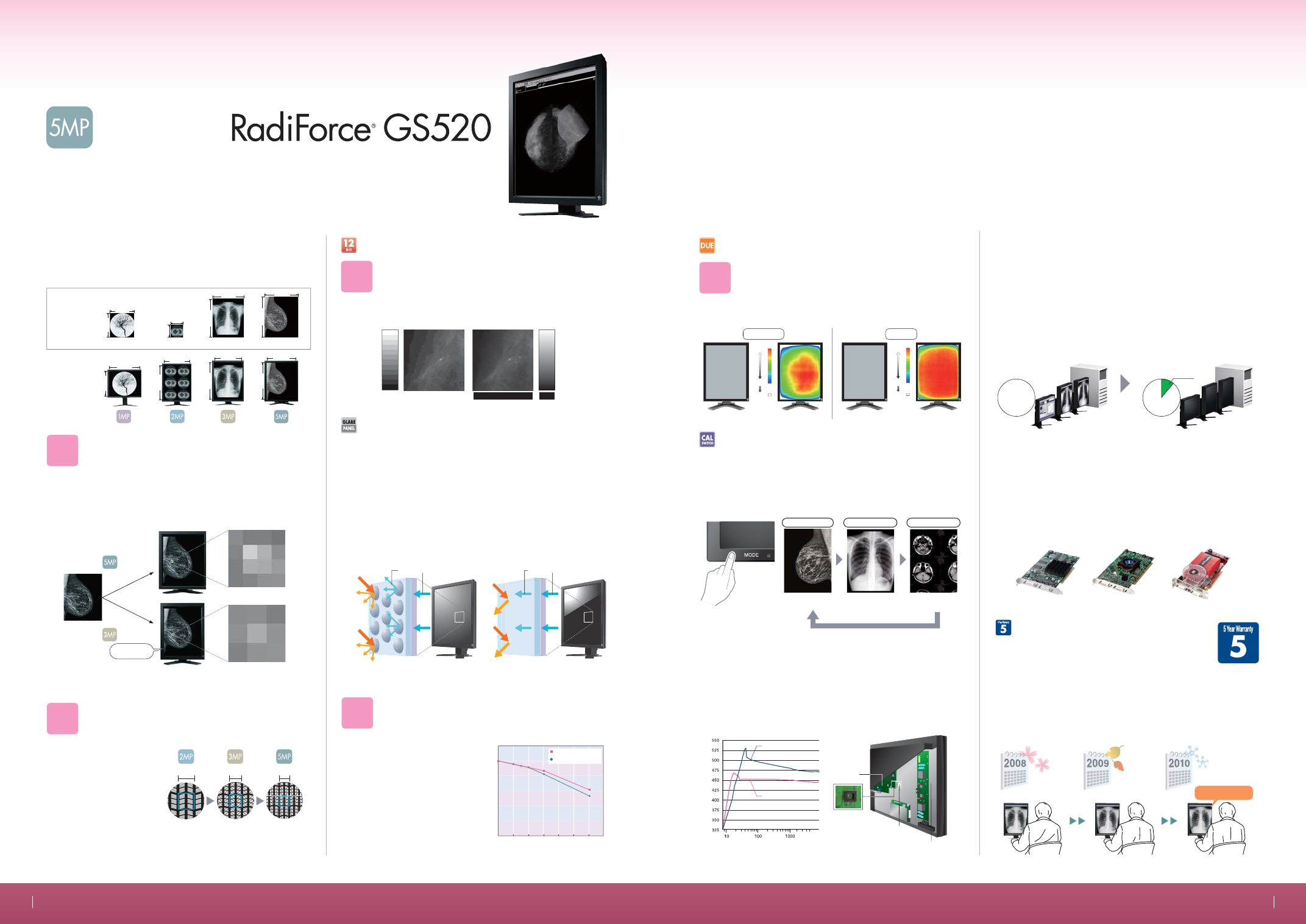
12-Bit Simultaneous Grayscale Display
Many current monitors use anti-glare panels, which have a waffled
surface to diffuse the reflection of surrounding light. However, this
also diffuses the light from the monitor’s backlight, which affects the
outline of an image, causing a viewing strain on the observer. With a
distinctive glare panel, there is no diffused reflection by the waffled
surface, and the outline of the image is displayed more clearly.
Therefore, the subtle images such as calcification and masses will be
easier to observe reducing the strain on the observer.
Sharper Resolution for Clearer Image Outline
MTF (Modulation Transfer Function) is a parameter to
define the display sharpness and resolution of a monitor
panel. The glare panel has better MTF characteristics than
the anti-glare panel meaning the
glare panel can be expected to
display the outline of a detailed
image more sharply.
256 Tones Image 4,096 Tones Image
12-bit graphics board and 12-bit viewer software needed for 12-bit display.
1.2
1
0.8
0.6
0.4
0.2
0
Spatial Frequency (Line pairs/mm)
Anti-Glare Panel
Glare Panel
0.0 0.5 1.0 1.5 2.0 2.5 3.0 3.5
High-Definition and High-Density with Minute Pixels
Enlarged Image
Enlarged Image
Digital
Mammography
3.14 million
pixels
5.24 million
pixels
Pixel Size Comparison
Brightness Stabilization
At startup or upon wakeup, the EIZO patented drift correction
function quickly stabilizes the brightness level. In addition, a sensor
measures the backlight brightness and compensates for brightness
fluctuations caused by the ambient temperature and the passage of time.
Compatibility with Various Graphics Boards
Supports various input signals for compatibility with a wide
range of graphics boards so the user can select the board
according to budget and performance requirements. This
includes single link and dual link signals, as well as packed-
pixel signal for users requiring 12-bit or 10-bit simultaneous
display.
Backlight Saver
With ScreenManager Pro for Medical utility software
installed, the Backlight Saver function allows for the monitor’s
backlight to turn off when the screen saver is activated and
the monitor’s backlight to turn on when the computer comes
out of the screen saver mode. This function helps to reduce
power consumption when the monitor is used for a prolonged
period of time.
High-Resolution for Delicate Grayscale Shadings
When selecting a monitor, it’s important to consider the “information
volume” of the medical images to be displayed.
Provided by Anjo Kosei Hospital
Please note that the reflection of surrounding light may increase when used in a bright environment.
Available with either a glare panel (GS520-CLG, GS520-BLG) or anti-glare panel (GS520-CL, GS520-BL).
This brightness stabilization function is EIZO patented technology (Japan patent numbers 3171808 and
3193315, US patent number 6188380).
0.165mm pixel size is the smallest pixel size among current
EIZO medical monitors providing high-definition and high-
density
display without shadings
appearing granular.
MammographyChest CR
Displaying
only 72%
DUE for Brightness Uniformity
Input Level 80%
=
204/255
CCD Camera
Brightness Map
Input Level 80%
=
204/255
CCD Camera
Brightness Map
100%
70%
lower
100%
70%
lower
EIZO's confidence in its product quality extends to brightness
stability which is also covered during the usage time specified in the
warranty.
Brightness Stability Within Usage Time Guaranteed
EIZO and its authorized distributors offer a five-year
limited warranty for RadiForce GS520.
Full 5-Year Warranty
Calibration Mode Selection
Selectable with the front panel buttons, the CAL Switch function
allows for various calibration modes of different modalities such as
digital mammography, CR, and CT images. Furthermore, with
ScreenManager Pro for Medical installed, auto mode settings can be
made with the Auto CAL Switch function.
Mammo Mode
Brightness : 500 cd/m
2
Grayscale : DICOM Part 14
Brightness : 450 cd/m
2
Grayscale : DICOM Part 14
Brightness : 350 cd/m
2
Grayscale : γ=2.2
CR Mode CT/MRI Mode
Without DUE With DUE
1
Requirement
3
Requirement
5
Requirement
4
Requirement
2
Requirement
To sustain image consistency, brightness uniformity is
required for medical imaging monitors. However, unified
luminance of the backlight is difficult to attain due to the
characteristics of LCD monitors. The Digital Uniformity Equalizer
(DUE) function provides optimum backlight luminance uniformity.
3
4
Distinctive Glare Panel
Featuring high-resolution, high-definition and multi-grayscale, the RadiForce GS520 is Featuring high-resolution, high-definition and multi-grayscale, the RadiForce GS520 is
designed specifically for digital mammography with a choice of distinctive glare panel to designed specifically for digital mammography with a choice of distinctive glare panel to
meet diversified environment usage.meet diversified environment usage.
MONOCHROME
LCD MONITOR
Medical
Images
(Example)
Monitor
Resolution
Glare Panel
Incoming
Light
Reflections
Anti-Glare Panel
Incoming
Light
Reflections
Light from Backlight Light from Backlight
Change modes
with one touch.
Backlight
Sensor
Backside
of Panel
Hole for
Light
Transmission
Other Manufacturer's Monitor
with Drift Correction
EIZO RadiForce Monitors
with Drift Correction
Seconds
Drift Correction Comparison
Backlights
switch off
automatically
Cuts power consumption
by 11%
18 hours / day
2 hours
16 hours / day
Along with EIZO's new frame rate control technology
(patent pending), 4,096 (12-bit) grayscale tones can be
displayed simultaneously from an abundant palette of
13,771 tones for high-definition digital mammography.
Main Board
Brightness (cd/m
2
)
“Information volume” of a digital mammography image
should exceed 5 million pixels. When a lower resolution
monitor displays this “information volume,” the monitor
stretches the information forcing the mosaic to appear as shadings.
With a 2048 x 2560 resolution or 5.24 million pixels, the stretching
effect is minimized and the mosaic becomes suitable for rendering
subtle masses and calcifications, within the mammography image.
Same Brightness !







